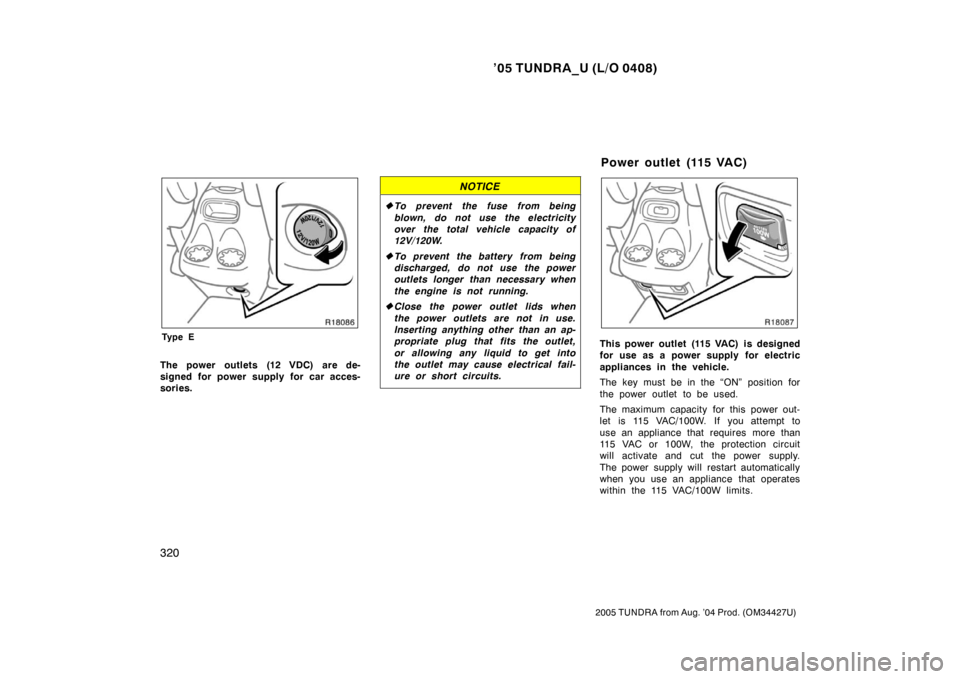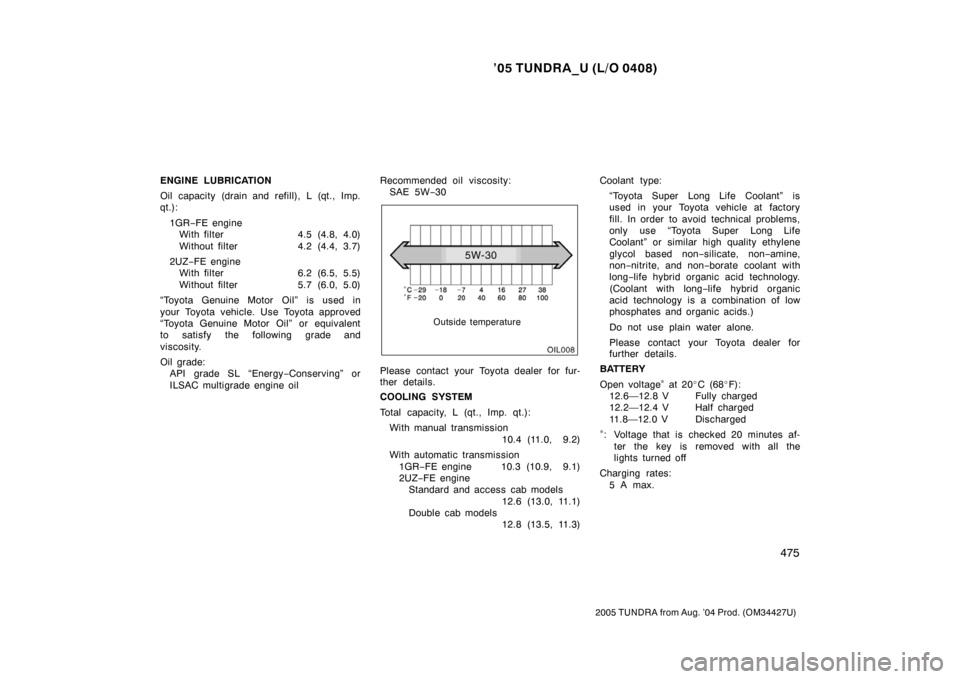Page 331 of 506

’05 TUNDRA_U (L/O 0408)
320
2005 TUNDRA from Aug. ’04 Prod. (OM34427U)
Ty p e E
The power outlets (12 VDC) are de-
signed for power supply for car acces-
sories.
NOTICE
�To prevent the fuse from being
blown, do not use the electricity
over the total vehicle capacity of
12V/120W.
� To prevent the battery from being
discharged, do not use the power
outlets longer than necessary when
the engine is not running.
� Close the power outlet lids when
the power outlets are not in use.
Inserting anything other than an ap-
propriate plug that fits the outlet,
or allowing any liquid to get into
the outlet may cause electrical fail-
ure or short circuits.
This power outlet (115 VAC) is designed
for use as a power supply for electric
appliances in the vehicle.
The key must be in the “ON” position for
the power outlet to be used.
The maximum capacity for this power out-
let is 115 VAC/100W. If you attempt to
use an appliance that requires more than
115 VAC or 100W, the protection circuit
will activate and cut the power supply.
The power supply will restart automatically
when you use an appliance that operates
within the 115 VAC/100W limits.
Power outlet (115 VAC)
Page 375 of 506

’05 TUNDRA_U (L/O 0408)
364
2005 TUNDRA from Aug. ’04 Prod. (OM34427U)
Ti r e relat ed ter mMeaning
Normal occupant weight68 kg (150 lb.) times the number of occupants specified in the second
column of Table 1 that follows
Occupant distributiondistribution of occupants in a vehicle as specified in the third column of Table
1 that follows
Production options weight
the combined weight of those installed regular production options weighing
over 2.3 kg (5 lb.) in excess of those standard items which they replace,
not previously considered in curb weight or accessory weight, including
heavy duty brakes, ride levelers, roof rack, heavy duty battery, and special
trim
Recommended inflation pressurecold tire inflation pressure recommended by a manufacturer
Rima metal support for a tire or a tire and tube assembly upon which the tire beads
are seated
Rim diameter (Wheel diameter)nominal diameter of the bead seat
Rim size designationrim diameter and width
Rim type designationthe industry of manufacturer ’s designation for a rim by style or code
Rim widt hnominal distance between rim flanges
Vehicle capacity weight
(Total load capacity or payload)the rated cargo and luggage load plus 68 kg (150 lb.) times the vehicle’s desig-
nated seating capacity
Vehicle maximum load on the tirethe load on an individual tire that is determined by distributing to each axle
its share of the maximum loaded vehicle weight and dividing by two
Page 388 of 506

’05 TUNDRA_U (L/O 0408)
377
2005 TUNDRA from Aug. ’04 Prod. (OM34427U)
Check the condition of the battery and
cables.
Cold temperatures reduce the capacity of
any battery, so it must be in top shape
to provide enough power for winter start-
ing. Section 7 −3 tells you how to visually
inspect the battery. Your Toyota dealer
and most service stations will be pleased
to check the level of charge.
Make sure the engine oil viscosity is
suitable for the cold weather.
See Section 7 −2 for recommended viscos-
ity. Leaving a heavy summer oil in your
vehicle during winter months may cause
harder starting. If you are not sure about
which oil to use, call your Toyota deal-
er—they will be pleased to help.
Keep the door locks from freezing.
Squirt lock de −icer or glycerine into the
locks to keep them from freezing. To open
a frozen lock, try heating the key before
inserting it.
Use a washer fluid containing an anti-
freeze solution.
This product is available at your Toyota
dealer and most auto parts stores. Follow
the manufacturer ’s directions for how
much to mix with water.NOTICE
Do not use engine antifreeze or any
other substitute because it may dam-
age your vehicle’s paint.
Do not use your parking brake when
there is a possibility it could freeze.
When parking, put the transmission into
“P” (automatic) or into first or reverse
(manual) and block the front wheels. Do
not use the parking brake, or snow or
water accumulated in and around the
parking brake mechanism may freeze,
making it hard to release.
Keep ice and snow from accumulating
under the fenders.
Ice and snow built up under your fenders
can make steering difficult. During bad
winter driving, stop and check under the
fenders occasionally.
Depending on where you are driving,
we recommend you carry some emer-
gency equipment.
Some of the things you might put in the
vehicle are tire chains, window scraper,
bag of sand or salt, flares, small shovel,
jumper cables, etc.
Your vehicle is not designed to be
dinghy towed (with four wheels on the
ground) behind a motorhome.
NOTICE
Do not tow your vehicle with four
wheels on the ground. This may
cause serious damage to your vehicle.
Dinghy towing
Page 486 of 506

’05 TUNDRA_U (L/O 0408)
475
2005 TUNDRA from Aug. ’04 Prod. (OM34427U)
ENGINE LUBRICATION
Oil capacity (drain and ref ill), L (qt., Imp.
qt.):
1GR −FE engine
With filter 4.5 (4.8, 4.0)
Without filter 4.2 (4.4, 3.7)
2UZ− FE engine
With filter 6.2 (6.5, 5.5)
Without filter 5.7 (6.0, 5.0)
“Toyota Genuine Motor Oil” is used in
your Toyota vehicle. Use Toyota approved
“Toyota Genuine Motor Oil” or equivalent
to satisfy the following grade and
viscosity.
Oil grade: API grade SL “Energy −Conserving” or
ILSAC multigrade engine oil Recommended oil viscosity:
SAE 5W −30
Outside temperature
Please contact your Toyota dealer for fur-
ther details.
COOLING SYSTEM
Total capacity, L (qt., Imp. qt.):
With manual transmission 10.4 (11.0, 9.2)
With automatic transmission 1GR −FE engine 10.3 (10.9, 9.1)
2UZ− FE engine
Standard and access cab models
12.6 (13.0, 11.1)
Double cab models 12.8 (13.5, 11.3) Coolant type:
“Toyota Super Long Life Coolant” is
used in your Toyota vehicle at factory
fill. In order to avoid technical problems,
only use “Toyota Super Long Life
Coolant” or similar high quality ethylene
glycol based non −silicate, non −amine,
non− nitrite, and non− borate coolant with
long− life hybrid organic acid technology.
(Coolant with long −life hybrid organic
acid technology is a combination of low
phosphates and organic acids.)
Do not use plain water alone.
Please contact your Toyota dealer for
further details.
BATTERY
Open voltage∗ at 20 �C (68 �F):
12.6—12.8 V Fully charged
12.2—12.4 V Half charged
11.8—12.0 V Discharged
∗: Voltage that is checked 20 minutes af-
ter the key is removed with all the
lights turned off
Charging rates: 5 A max.